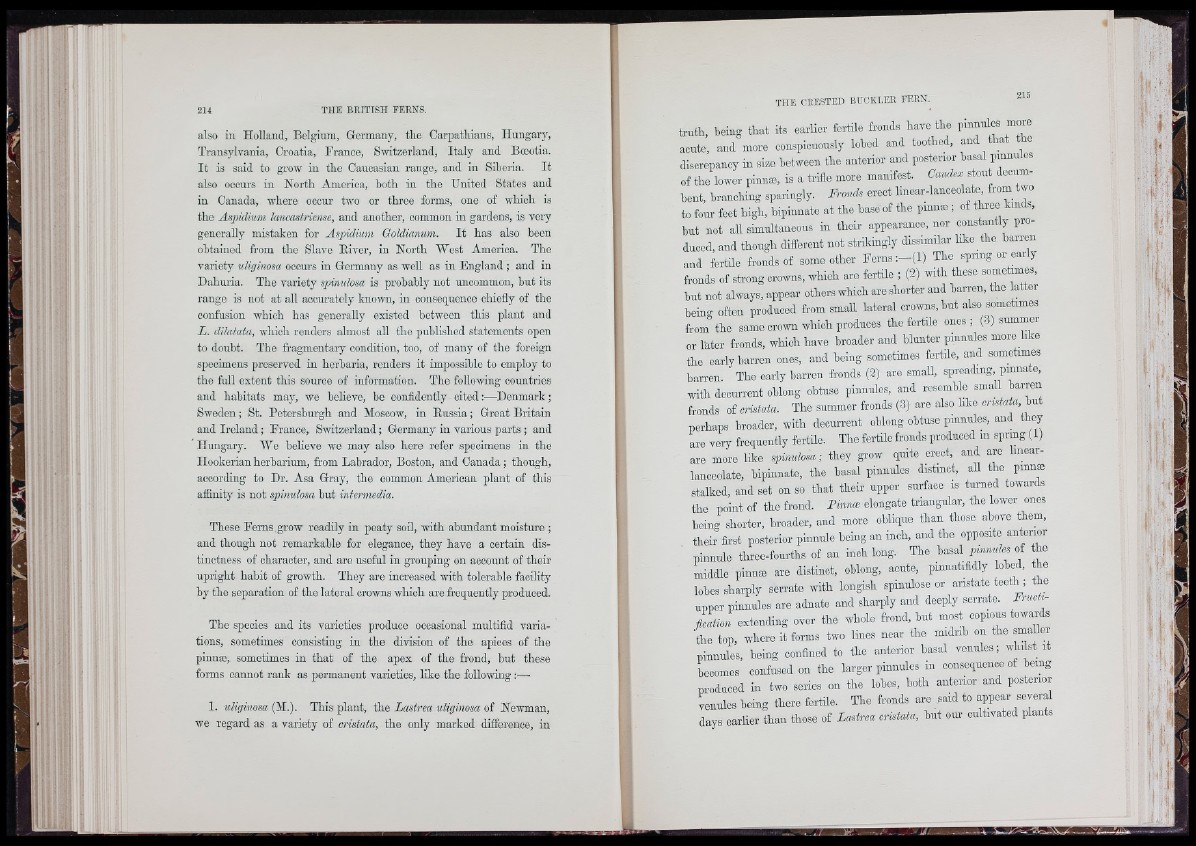
also in Ilollimd, Belgium, Germany, the Carpathians, Hungary,
Transylvania, Croatia, France, Sivitzerland, Italy and Boeotia.
I t is said to grow in the Caucasian range, and in Siberia. I t
also ooours iu North America, both in the United States and
in Canada, where occur two or throe forms, one of which is
the Aspidium lancastriense, and another, common in gardens, is very
generally mistaken for Aspidium Ooldianum. I t has also boon
obtained from tho Slave River, in North West America. The
variety uliginosa ooours in Germany as well as in England ; and in
Dahuria. The variety spinulosa is probably not uncommon, but its
range is not at all accurately known, in consequence chiefly of the
confusion which has generally existed between this plant and
L . dilatata, which renders almost all tho published statements open
to doubt. The fragmentary condition, too, of many of the foreign
specimens preserved in herbaria, renders it impossible to employ to
the full extent this source of information. The following countries
and habitats may, we believe, be confidently cited :—Denmark ;
Sweden ; St. Petershurgh and Moscow, in Russia ; Great Britain
and Ireland; France, Switzerland; Germany in various parts ; and
Hungary. We believe we may also here refer specimens in the
Hookerian herbarium, from Labrador, Boston, and Canada ; though,
aooording to Dr. Asa Gray, the common American plant of this
affinity is not spinulosa hut intermedia.
These Ferns grow readily in peaty soil, with abundant moisture ;
and though not remarkable for elegance, they have a certain distinctness
of oharaoter, and are useful in grouping on account of their
upright habit of growth. They aro increased with tolerable facility
by the separation of the lateral crowns which are frequently produced.
The species and its varieties produce occasional mnltifid variations,
sometimes consisting in the division of the apices of the
pinnæ, sometimes in th a t of the apex of the frond, hut these
forms cannot rank as permanent varieties, like the following ;—
1. uliginosa (M.). This plant, the Lastrea tiliginosa of Newman,
wo regard as a variety of cristata, the only marked difference, in
truth, being th a t its earlier fertile fronds have the pmnules more
acute, and more conspicuomsly lohod and toothed, and that the
discrepancy in size between the anterior and posterior basal pinnules
of the lower pinnæ, is a triflo moro manifest. Caudex stout docum-
hent, branching sparingly. Fronds orect hnear-lancoolate, from two
to four feet high, hipinnate at the base of the pmnæ ; of thioe kind ,
hut not all simultaneous in their appearance, nor constantly produced,
and though different not strikingly dissimilar like the barren
and fertile fronds of some other Ferns : - ( ! ) The spring or early
fronds of strong crowns, which aro fertile ; (2) with these sometimes,
but not always, appear others which are shorter and barren, the latter
being often produced from small lateral crowns, hut also sometimes
from the samo croivn which produces tho fertile ones ; (3) summer
or later fronds, which have broader and blunter pinnules more like
tho early barren ones, and being sometimes fertile, and sometimes
barren. The early barren fronds (2) aro small, spreading, pinnate,
with decurrent oblong obtuse pinnules, and resemble small barren
fronds of cristata. The summer fronds (3) are also like cristata, hut
perhaps broader, with decurrent oblong obtuse pmnules, and they
are very frequently fertile. The fertile fronds produced in spring (1)
are more like spinulosa; they grow quite orcot, and are linear-
lanceolate, hipinnate, the basal pinnules distinct, all the pmnæ
stalked, and set on so that their upper surface is turned towards
the point of the frond. Pinnm elongate triangular, the lower ones
being shorter, broader, and more oblique than those above them,
their first posterior pinnulo hoing an inch, and the opposite anterior
pinnule three-fourths of an inch long. The basal pinnules of he
middle pinnæ are distinct, oblong, acute, pinnatifidly lohed, the
lobes sharply serrate with longish spinulose or aristate teeth ; the
upper pinnules aro adnate and sharply and deeply serrate. Fiucti-
fieation extending over tho whole frond, but most copious towards
the top, where it forms two lines near the midrib on the smallei
pinnules, being confined to the anterior basal venules; whilst it
becomes confused on tho larger pinnules in consequence of being
produced in two series on the lobes, both anterior and posterior
venules being there fertile. The fronds are said to appear several
days earlier than those of Lastrea cristata, hut onr cultivated plants
A : ,
t ■; i
‘ V